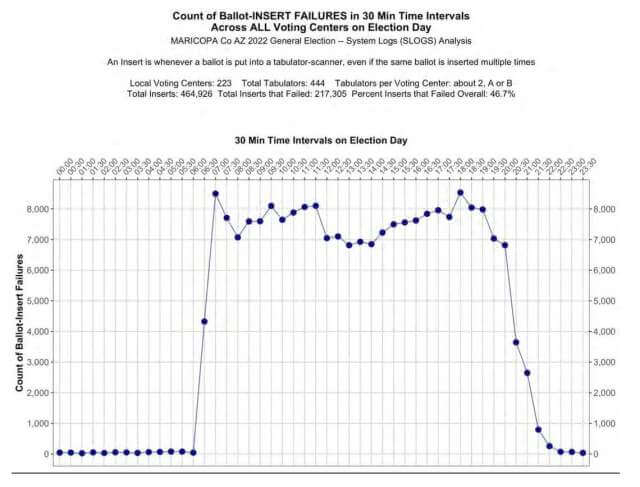Lake voters turned out 3:1 (the mail-in votes heavily favored Hobbs). 60% of the voting machines failed on election day, causing four-hour-long lines and mass voter disenfranchisement. Many voters left without voting or avoided going to the polls altogether. Those voters who made it into the polling facilities were given the option to leave, wait, or drop their ballot in a box called “door 3.” The ballots were then placed in plastic bags and returned to county facilities where Hobbs’s officials counted the votes. Hobbs won. It was the closest election in decades, with a margin of 0.0067.

Highlights
The Writ covers the legal grounds for the case, standing, related cases, Maricopa’s 2022 election, factual background, legal background, authorities, statutes, rules, regulations, and orders (the boring legal stuff). What I found interesting, however, were the exhibits in the appendices of both the writ and the motion to expedite. Some highlights:
An analysis of the Cast Vote Records (CVRs) found that the Maricopa and Pima county ballots were artificially processed in an algorithm to maintain an outcome at a predetermined ratio. “Such a uniform and predictable pattern is so statistically implausible that it would not occur without artificial manipulation.”
A cybersecurity expert who examined a copy of the Maricopa County’s election system’s database and forensic images concluded that “the voters of Maricopa County should have no confidence that their votes have been accurately counted, if they were even counted at all. The egregious security violation discovered, concerning the encryption keys utilized by the voting system only reinforces this conclusion”.
The secret encryption keys (Rijndael Key, a Rijndael Vector, a Hash-based Message Authentication Code) and x509 certificate used to encrypt and decrypt the election data, and used for authentication during file transfers and communication, are stored in plain text. They are left unprotected, out in the open, and easy to find. With these keys, anyone could manipulate system configuration files, causing the tabulators to not function properly. They could create or duplicate election data and make it appear authentic. The possibilities are endless.
Some of the packages found on the voting machines were:
- Net Framework ver. 3.5
- Microsoft Visual J# ver 2.0
- Microsoft Visual C++ 2015 Redistributable
- Microsoft Visual C++ 2013 Redistributable
- Java Runtime Environment ver 7u80
- Java Runtime Environment ver 8u144
These programs can modify and create executables and drivers on the fly and are not part of the approved or certified software. 12,507 executables were created or modified after the installation date. Three of these were created during the actual voting process.
None of the system’s antivirus definitions were ever updated after the election software was installed. For Maricopa County, this was over 19 months. During that time, 570,000,000 pieces of malicious code were released.
Windows operating systems did not receive system patches for more than 19 months after the election software was installed. These patches included fixes for 3,512 known vulnerabilities that were directly applicable to the Maricopa County voting system.
Q. What about passwords, were those protected?
A. So they did have a password. And the reason I used “a password” was they used the same password for every single account on the domain on the system.
Bottom Line
As the years pass and evidence mounts that computerized electronic voting machines are vulnerable, more and more people are distrustful of elections. Polls show that anywhere from a third to over 2/3 of Americans believe that voting is rigged or that there has been and is fraud in elections. Either way, either a large minority or a majority of Americans do not trust elections, and electronic voting machines are a big part of that.
I am not an expert on voting, but I have been using computers for decades. One thing I do know is that every computer is vulnerable to attacks of various kinds. Also, with a few lines of code, computers can be programmed to manipulate data in all sorts of ways.
Let me know in the comments if you think computers should be used in elections.
- Should Computers Be Used In Elections? – Part 1
- Should Computers Be Used In Elections? – Part 2
- Should Computers Be Used In Elections? – Part 3 ⬅ You are here
—

I don’t trust a certain side of politics at all and with a paper ballot there is a physical record that can be verified in the event of either side calling foul. Luckily we don’t allow the ballot harvesting we see in the US which is clearly a risk to a free and fair election with vans turning up to the ballot offices at 3am in the morning overflowing with completed ballot papers all for one side and long after voting scrutiny had finished for the day.
Until we can be assured that electronic voting cannot be tampered with (and your articles certainly seems to suggest there are issues yet to be resolved) I want to see our system in Oz continue.
Searchng the Internet for this important essay by John Durso brings up–nothing! So why, with all due respect, does it first appear here, in a limited circulation publication, rather than being covered by major news outlets? Is there nothing being done to get it into the spotlight?
Should we continue with archaic voting machines and systems that can produce fraud. In the short term, yes but there must be a plan to go to computer voting in the next 3-5 years. The problem is paper ballots and various ways to count the votes worked when you had many fewer people voting. Now with tens of millions of votes, we must use a system where votes are tablulated via a trusted computer system. There is a cost of course but it is the only way. The computer can start with a fingerprint or eye scan or even DNA. The software must require six sigma quality control just like airplanes require. I’ll repeat, if we make this work for pensions, IRA’s and paychecks; we can make it work for voting. Imagine if these sysems were not hack proof or trustworthy. Any other method is so prone to fraud that computer voting must become the only process. When Trump claimed fraud and we had videos of fraud, the investigations were stopped. Then the liberal press said no evidence of fraud was found to support Trump’s allegations. Of course nothing was found because the investigation of spurious activity was not followed up. I don’t care if Trump won or lost to be honest, but fraud occurred and will get worse without a wholesale change in the voting process.